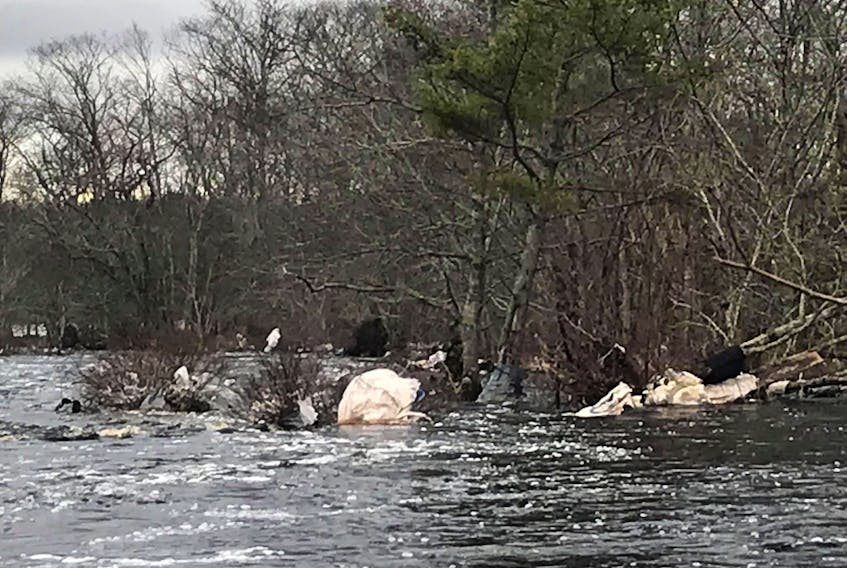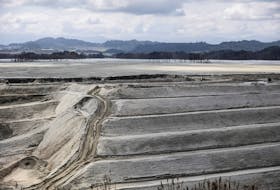TUSKET, N.S. — A variety of sand bags, barriers and tarp-type plastics is washing down the river below the Tusket dam, tangled in branches and shrubs along the shoreline.
The litter originates from the site of NS Power’s Tusket dam project, which has been inactive for months.

Yarmouth County resident Nancy Lakusta says she reported the litter twice to the Department of Environment but it keeps happening every time the dam is opened.
“This is just what gets caught up, (in the branches). I can’t imagine what goes to the ocean,” she says.

Jacqueline Foster, senior communications advisor for Nova Scotia Power, says Nova Scotia Power takes its environmental responsibilities very seriously.
The company has strict safety and environmental protocols that are enforced at all work sites and facilities, she adds.
“Once we became aware of the debris, we reached out to our contractor immediately. Our contractor is ready to retrieve it from the area as soon as it is safe to do so. At this time, the water level of the river is too high and too dangerous to safely retrieve the debris.”
Other stories about the Tusket dam project:
- Oct. 6, 2017 Tusket dam refurbishment project on track
- Sept. 16, 2019 Remaining schedule outlined for Tusket dam refurbishment project
- Jan. 2, 2020 Detour by Tusket Dam extended to Jan. 31
- Feb. 28, 2020 Hurlburt Falls Bridge replacement now open
- July 11, 2020 NS Power proposing lowering of lakes in connection with Yarmouth County dam project
The water level is required by the Nova Scotia Department of Environment to be kept within a certain range, which requires the gates at the dam to be opened to allow water to be passed downstream when necessary. Due to recent heavy inflows to the system, NS Power has had to keep the gates open to maintain water levels.
Lakusta says she agrees that NS Power has to wait until it is safe to retrieve the debris from the middle of the river, but feels that there is still a lot they can retrieve from the river banks at this time.
“I also hope that they are making a plan to ensure that this type of debris doesn’t end up in the river again.”
Status of refurbishment project
The Tusket Dam refurbishment work began in the summer of 2017, but has been repeatedly delayed by issues that included inadequate consultation with indigenous communities – since resolved through the Nova Scotia Utility and Review Board – and also construction difficulties and the subsequent need to lower the Lake Vaughan reservoir and two associated lakes (Gavels and Kings Lake) to their natural level.
COVID-19 was the latest roadblock.
Improvements accomplished to date include building one of the eight concrete bays of the new main dam (2019), attaching a concrete core wall to the new main dam structure (2019), and replacing the Hurlburt Falls Bridge (opened to the public in February 2020).
The remaining work involves seven concrete bays that have to be built; new vertical lift gates that need to be installed, as well as a structure to lift and lower the gates. The existing dam also has to be removed. It is expected to take two construction seasons to finish the work.
Construction will resume later this year.
Foster says the existing dam remains safe for local residents and regular inspections of the dam and the safe operation of the dam gates will continue.
“We will continue to engage with the Mi’kmaq, local residents and other stakeholders as we move forward with construction plans for this summer," she says. "We will provide residents with an updated timeline once the project work plan has been confirmed."
In November 2020, NS Power filed its 2021 Annual Capital Expenditure (ACE) Plan with the NS Utility and Review Board. It noted the cost of the Tusket project to be $32.3 million, says Foster. The original project estimate was $18 million.









